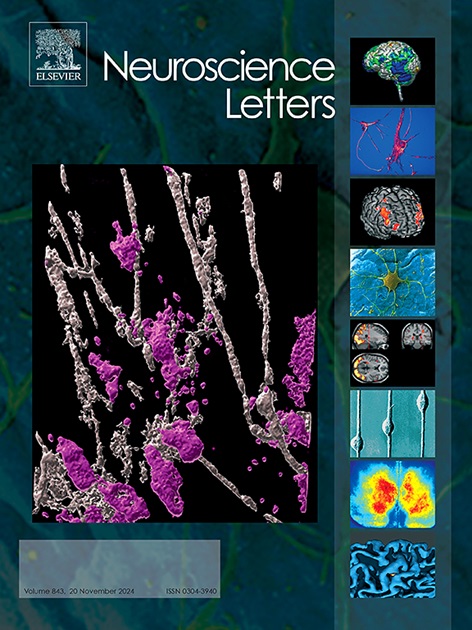1-Epilupinine增强东莨菪碱诱导的痴呆模型小鼠的认知能力并减少炎症
IF 2
4区 医学
Q3 NEUROSCIENCES
引用次数: 0
摘要
痴呆症是一个日益严重的全球公共卫生问题。寻找副作用更小的有效抗痴呆症药物,特别是在疾病的早期阶段,是当前研究的一个重点。天然化合物如1- epilupine (ELP)可能具有改善认知和保护神经的治疗潜力。为了评估ELP在东莨菪碱诱导的小鼠痴呆模型中改善痴呆和神经炎症的潜力,我们用氢溴酸东莨菪碱诱导小鼠模型,以多奈哌齐为阳性对照。治疗5天后,使用Morris水迷宫测试评估认知表现。通过开场测试评估运动功能和焦虑相关行为。采用炎症因子阵列测量前额叶皮层的炎症标志物。Morris水迷宫实验显示,氢溴酸东莨菪碱(1 mg/kg)处理的模型组小鼠穿越平台次数明显减少,潜伏期明显延长(P <;0.001),而ELP (5 mg/kg)处理的小鼠表现出更好的表现,交叉次数更多,潜伏期缩短(P <;0.01),提示ELP能有效逆转认知缺陷。在开场试验中,elp处理组的总运动距离无显著差异,表明其不影响运动功能。炎症因子阵列检测结果显示,ELP (5 mg/kg)组GM-CSF、IFN-γ、IL-2和IL-23水平显著降低,提示其可能具有抗炎治疗痴呆的作用。因此,ELP可能作为早期痴呆的一种有希望的治疗方法,提供认知改善和抗炎神经保护。本文章由计算机程序翻译,如有差异,请以英文原文为准。
1-Epilupinine enhances cognition and reduces inflammation in scopolamine-induced dementia model mice
Dementia is a growing global public health concern. The search for effective anti-dementia drugs with fewer side effects, particularly in the early stages of the disease, is a key focus of current research. Natural compounds like 1-Epilupinine (ELP) may offer therapeutic potential for cognitive improvement and neuroprotection. To assess the potential of ELP in improving dementia and neuroinflammation in a scopolamine-induced dementia model in mice, a mouse model was induced using scopolamine hydrobromide, with Donepezil as the positive control. After five days of treatment, cognitive performance was assessed using the Morris water maze test. Motor function and anxiety-related behaviors were evaluated through the open field test. An inflammatory factor array was employed to measure inflammatory markers in the prefrontal cortex. The Morris water maze showed that the model group treated with scopolamine hydrobromide (1 mg/kg) had significantly fewer platform crossings and longer latency (P < 0.001) while mice treated with ELP (5 mg/kg) exhibited improved performance, with more crossings and reduced latency (P < 0.01), suggesting ELP effectively reversed cognitive deficits. In the open field test, no significant difference of total movement distance was detected in ELP-treated groups, indicating it did not impair motor function. The result of the inflammation factors array detecting showed lower levels of GM-CSF, IFN-γ, IL-2, and IL-23 significantly in the ELP (5 mg/kg) group, suggesting its potential anti-inflammatory properties for the dementia treatment. Therefore, ELP may serve as a promising treatment for early-stage dementia, offering cognitive improvement alongside anti-inflammatory neuroprotection.
求助全文
通过发布文献求助,成功后即可免费获取论文全文。
去求助
来源期刊

Neuroscience Letters
医学-神经科学
CiteScore
5.20
自引率
0.00%
发文量
408
审稿时长
50 days
期刊介绍:
Neuroscience Letters is devoted to the rapid publication of short, high-quality papers of interest to the broad community of neuroscientists. Only papers which will make a significant addition to the literature in the field will be published. Papers in all areas of neuroscience - molecular, cellular, developmental, systems, behavioral and cognitive, as well as computational - will be considered for publication. Submission of laboratory investigations that shed light on disease mechanisms is encouraged. Special Issues, edited by Guest Editors to cover new and rapidly-moving areas, will include invited mini-reviews. Occasional mini-reviews in especially timely areas will be considered for publication, without invitation, outside of Special Issues; these un-solicited mini-reviews can be submitted without invitation but must be of very high quality. Clinical studies will also be published if they provide new information about organization or actions of the nervous system, or provide new insights into the neurobiology of disease. NSL does not publish case reports.
 求助内容:
求助内容: 应助结果提醒方式:
应助结果提醒方式:


